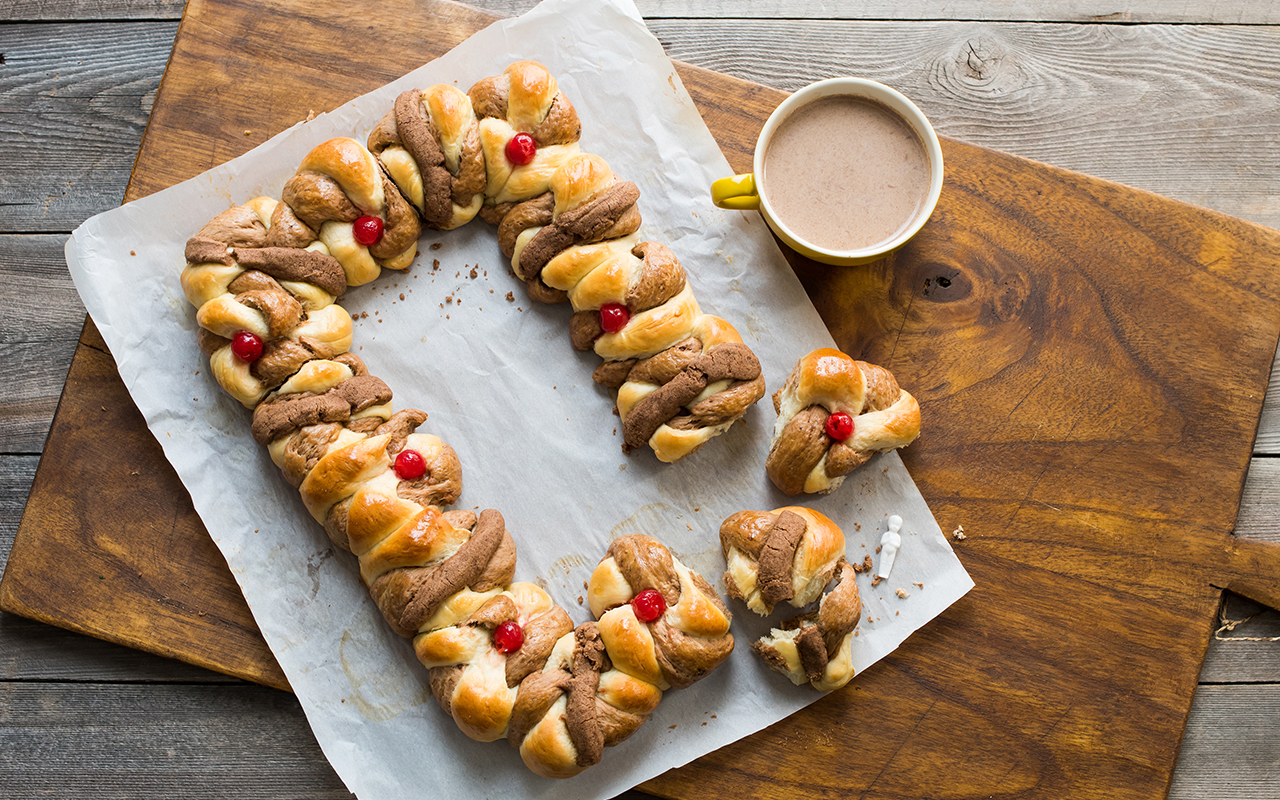Rosca de Reyes Abuelita

Not so common these days, (before the commercialization of Santa Claus and the Christmas holiday), Mexico, Spain and other Latin countries used to receive the majority of their gifts from the Three Kings rather than from Santa Claus at Christmas.
Before going to bed, on the night of January 5th, children would place their old shoes or a box filled with grass or hay under their bed for the camels with a wish list on top for the Three Kings. In the morning of January 6, the shoes or box would be filled with toys and gifts from the Three Kings (or Wise Men –Caspar (Gaspar), Melchior (Melchor) and Balthazar (Baltazar).
The family would then feast on a “Rosca de Reyes” also called Three Kings Cake or bread roll of the kings. The Rosca de Reyes is ring shaped sweet bread with a small doll baked inside which represents baby Jesus. The doll figure symbolizes the hiding of the infant Jesus from King Herod’s troops. According to tradition whoever finds the little figurine in their slice of sweet bread must host a party on February 2nd, Candlemas Day or Dia de la Candelaria, offering tamales, hot chocolate and atole to their guests. Candlemas is the day that Mary presented the infant Jesus to the temple and is traditionally the day that candles are blessed in the Catholic Church.
According to an old legend based on a Bible, these three kings (The Magi) saw a bright star on the night when Christ was born. They followed it to Bethlehem and found there the Christ child and presented it with gifts of gold, frankincense and myrrh. On the Christian calendar, the twelfth day after Christmas is known as “Epiphany”, “Twelfth Night”, or “Kings Day.”
Nowadays, I don’t know many families that go to the extent as celebrating Kings Day with gift giving. Many just purchase or make the “Rosca de Reyes” from scratch, bond with loved ones over a nice hot cup of champurrado or hot chocolate, tell stories and reminisce over old family photos.
This year, I decided to treat my family with a rosca made with Chocolate Abuelita inside the dough and as part of the sweet paste that adorns this treat. This particular recipe is portioned for you. No knives are needed because each portion is a chocolate/vanilla knot that can easily be pulled from the entire rosca.
I had so much fun developing this recipe for Abuelita and El Mejor Nido because Mexican chocolate is one of our favorite treats that can now be incorporated into one of our favorite family gatherings.
For more Abuelita recipes and cooking ideas, follow along on Facebook or visit El Mejor Nido.
Print
Rosca de Reyes Abuelita
- Yield: 15–16 1x
Ingredients
FOR DOUGH
- 1 packet (7 grams) active-dry yeast
- ½ cup warm water (110° F)
- 4 cups all-purpose flour, divided
- 1/3 cup granulated sugar
- 1/3 cup butter, softened
- 3 large eggs, at room temperature, divided
- ½ teaspoon vanilla extract
- ½ teaspoon salt
- 1/3 cup warm milk
- ½ to 1 teaspoon vegetable oil for oiling bowl
- 8 Marachino cherries to decorate
- 3 small plastic baby figurines (optional)
FOR CHOCOLATE PASTE
- ½ cup (1 stick) butter, softened
- 1 cup all-purpose flour
- 1 Chocolate Abuelita tablet, grated (or 2/3 cup Abuelita Granulado)
Instructions
FOR DOUGH:
- Combine yeast and water in a small bowl. Let stand for at least 10 minutes until yeast turns foamy.
- Place 2 cups flour on a working surface. Make a well in the middle of flour and add sugar, butter, 2 eggs, vanilla extract and salt. Mix by hand, adding remaining flour ½ cup at a time until a smooth and lightly sticky dough is formed. Slowly add yeast mixture and milk, 1 tablespoon at a time to dough and knead for 5 to 7 minutes more until dough is completely smooth and elastic.
- Shape the dough into a ball and transfer (crease side down) to a large oiled bowl. Brush a small amount of oil with hands over surface of dough. Cover with plastic wrap and place in a warm area for 2 hours or until dough doubles in size. Meanwhile, prepare chocolate paste.
FOR CHOCOLATE PASTE:
- Beat butter with a hand mixer until smooth. Add flour and Abuelita chocolate and continue beating until completely mixed and a paste is formed. Divide chocolate paste into thirds.
- Deflate dough by pressing with fingers. Divide dough in half.
- Incorporate 2/3 chocolate paste in one half of the dough. Knead until dough changes color.
- Line a large baking tray with parchment paper.
- Roll 2 tablespoons dough in between palms of hand or on a surface making a 6 ½ -7” long strip. Repeat with chocolate dough. Twist both dough strips together, pinch ends together to form a circle or knot. Place on prepared baking sheet. Repeat until all dough is used, arranging the dough circles/knots in a larger circle (rosca shape). Dough twists make approximately 15-16 circles/knots. Optional: Wrap plastic baby figurines in the middle of a rolled out strip of dough. Make sure it is completely covered by dough.
- Cover dough knots with plastic wrap and place in a warm area to rise for 30 minutes.
- Preheat oven to 375° F.
- Shape the remaining 1/3 chocolate paste into 3-inch strips between the palms of your hands. Arrange them around the formed rosca, over the dough knots. Arrange Marachino cherries around rosca in centers of knots.
- Beat remaining egg. Brush rosca with beaten egg avoiding chocolate paste.
- Bake for 25-30 minutes or until bread is golden brown.
Notes
You can also make the dough using a stand mixer fitted with the hook attachment.
Nutrition
- Serving Size: 1 knot per serving
Recipe developed for Nestle Abuelita. Photo courtesy of Nestle.


